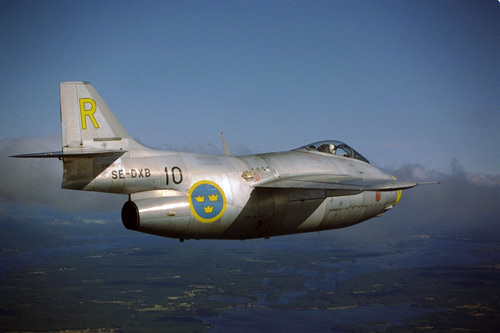J-29 Tunnan
Summary
| Category | Combat Aircraft |
| Origin country | 🇸🇪 Sweden |
| Manufacturer | Saab |
| First flight | 1 September 1948 |
| Year introduced | 1952 |
| Number produced | 661 units |
| Average unit price | $1 million |
Description
Work on what would become the Tunnan commenced in late 1945, internally designated R 1001. The design featured a distinctive barrel-like fuselage to accommodate the de Havilland Ghost turbojet engine. Wartime aerodynamic research from Germany indicated the favorable high-speed qualities of a swept-wing configuration, resulting in its adoption. The Swedish Air Force placed an initial order for three prototypes under the service designation J 29 during Autumn 1946. On 1 September 1948, the first prototype performed its maiden flight; flight testing proved the aircraft exceeded performance estimates in several aspects. Quantity production commenced in 1948; during May 1951, Bråvalla Wing (F 13) received the first production aircraft. Between 1950 and 1956, 661 Tunnans were completed, the largest production run for any Saab aircraft.
The Saab 29 Tunnan was specifically designed for jet propulsion, featuring a distinctive barrel-like fuselage to accommodate the de Havilland Ghost turbojet engine. Its relatively thin, mid-mounted wing had a 25-degree sweep, based on wartime German aerodynamic research, attached to the fuselage by four bolts. The undercarriage was hydraulically operated and retracted into the fuselage to maintain the wing's thin profile. To enhance pilot survivability, the Tunnan incorporated an ejection seat developed by Saab, complete with an explosive canopy jettison system. The engine was bolted to the fuselage at three points and could be removed with a special trolley for maintenance. Later versions featured an afterburner and a dog-tooth leading edge on the wing to improve the critical Mach number.
The Saab 29 Tunnan was armed with four 20 mm akan m/47C autocannons, a license-produced version of the Hispano Mark V, each equipped with 180 rounds. For external stores, it featured eight inner hardpoints for rocket or missile pylons; due to landing gear constraints, the innermost hardpoint was capable of carrying only smaller rockets. Two outer hardpoints could accommodate drop tanks or incendiary bombs. Tests explored the carriage of rockets using dedicated pylons on these hardpoints. The Tunnan could carry 75 mm srak m/55 air-to-air rockets, 80 mm prak m/46C air-to-ground rockets, 145 mm psrak m/49 or 150 mm srak m/51 air-to-ground rockets, and 180 mm hprak m/49 air-to-ground rockets. The J 29F variant was also capable of carrying Rb 24 (AIM-9B Sidewinder) air-to-air missiles on the third hardpoint from the center. For ground attack, the aircraft could be equipped with 200 kg brandb m/51 incendiary bombs. Its 600 kg drop tanks could be configured as incendiary bombs or filled with napalm.
The Saab 29 Tunnan saw operational use in several contexts. Within Sweden, it served in both fighter and fighter-bomber roles and set speed records. Early service was marked by a high crash rate, partly attributed to the lack of a dedicated trainer variant. The Tunnan was exported to Austria and operated until 1972; some Austrian models were modified for reconnaissance with camera pods installed in the nose. The Tunnan became the first Swedish jet aircraft to engage in combat when deployed to the Republic of Congo as part of a UN peacekeeping mission (ONUC) in the 1960s. J 29Bs conducted ground attacks, proving effective despite facing ground fire.
Main Variants:
-
J 29A: The first model to enter service, a fighter variant.
-
J 29B: A more capable fighter variant with enhancements.
-
J 29E: An improved fighter variant with further refinements.
-
J 29F: The final fighter variant, equipped with an afterburner.
-
S 29C: A dedicated aerial reconnaissance model.
Technical specifications
| Version: J 29F | |
|---|---|
| Crew | 1 pilot |
| Operational range | 1,100 km (684 mi) |
| Maximum speed | 1060 km/h (659 mph) |
| Wing area | 24.2 m² (259.9 sqft) |
| Wingspan | 10.2 m (33.6 ft) |
| Height | 3.8 m (12.3 ft) |
| Length | 11 m (36.1 ft) |
| Service ceiling | 15,500 m (50,853 ft) |
| Empty weight | 4,845 kg (10,681 lbs) |
| Max. takeoff weight | 8,375 kg (18,464 lbs) |
| Climb rate | 32.1 m/s (105.3 ft/s) |
| Powerplant | 1 x turbojet Volvo RM2B delivering 2753 kgf each |
| Ejection seat | SAAB Mk-2 |
Current operating countries
Armament
Missiles payload:
- Air-to-Air Short-Range Raytheon AIM-9 Sidewinder

